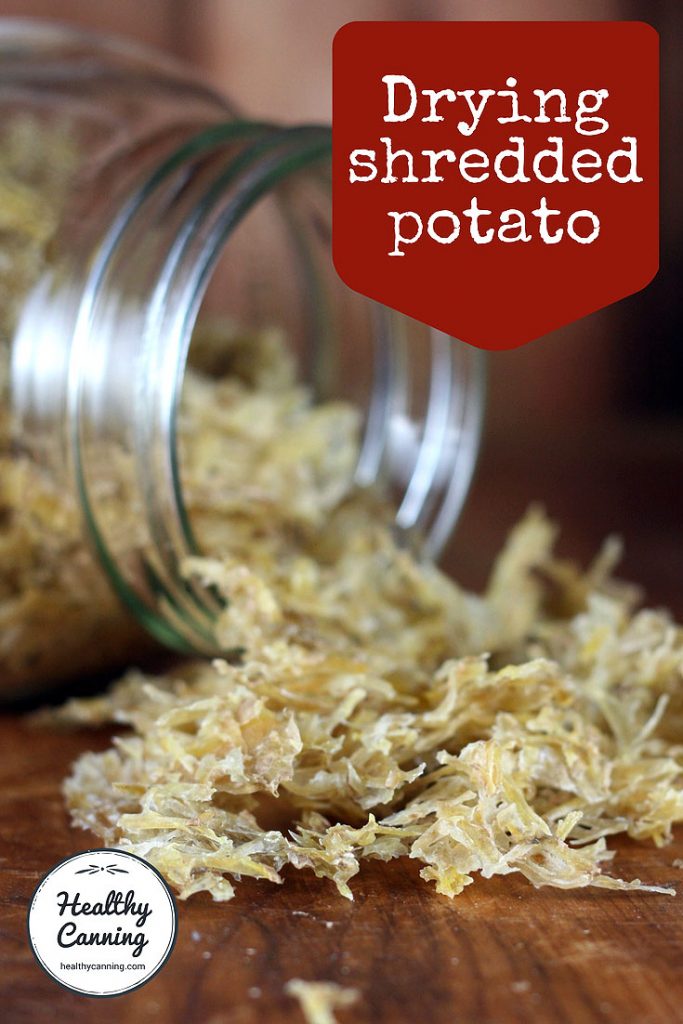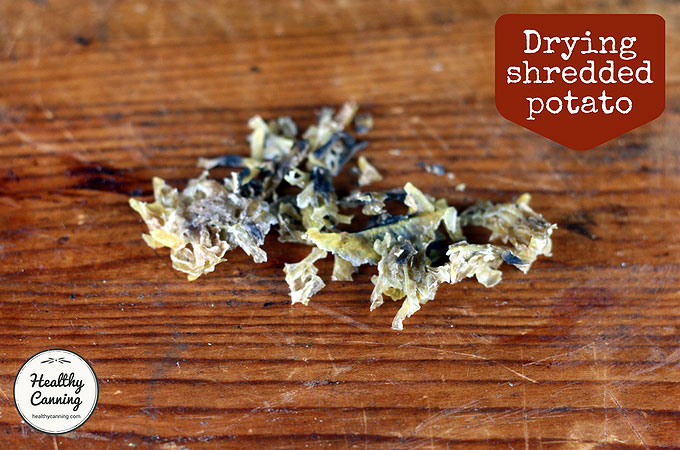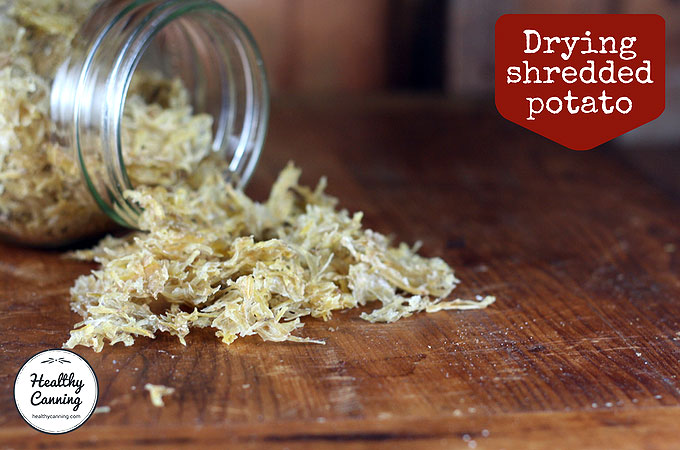Here are directions on how to dry shredded potatoes. They can then be stored, and drawn on as a ready-to-use ingredient in making other dishes, such as for instance hash browns or other dishes calling for shredded potato.
The potatoes are blanched first before dehydrating to prevent them turning an unappealing black.
See also: Canning potatoes, Drying potato slices
Yields and Equivalents
4.5 kg potatoes (10 lb), peeled, shredded and blanched = 6 to 7 Excalibur trays = 300 g (10 oz / 10 cups) shredded, dried
1 cup dried, shredded = 30 g – 40 g (just over 1 generous oz)
Directions
Here we compare directions from three different sources.
Ball All New
Preparation: “Wash, peel, dice… to ¼-inch (.5 cm) thick pieces.”
Blanching: Steam blanch 5 to 6 minutes. Rinse to remove starch after steaming.
Temperature: 125 F / 52 C
Time: Until crisp.
Reference: Ball All New, 2016. Page 340.
Excalibur
Preparation: “Wash potatoes to remove dirt; peel if desired. Grate.”
Blanching: “Steam blanch 4 to 6 minutes, then rinse in cold clear water; you may add 1 teaspoon sodium bisulfite per cup water to steaming solution. (Without blanching, some potatoes may turn black during drying.)”
Temperature: 125 F / 52 C
Time: “Should be brittle to semi-transparent. Test carefully since any lingering moisture can cause the entire batch to mold.” Time estimate is 6 to 10 hours, depending on humidity in your area.
Quality: Good
Reference: Excalibur. Preserve it naturally. 4th edition, 2012. Page 26 and 58.
Notes: “Select crisp new potatoes that are mature and undamaged. The tubers should be smooth with shallow eyes. Russett Burbank, White Rose, and Norgold Russet are good drying varieties. Potatoes must be fresh to maintain their good taste when rehydrated; the skins on old potatoes will become tough and leathery…..”
So Easy To Preserve
Preparation: “Wash, peel. Cut into shoestring strips ¼ inch (½ cm) thick.”
Blanching: Steam blanch 6 to 8 minutes; water blanch 5 to 6 minutes.
Temperature: 140 F / 60 C
Time: 8 to 12 hours.
Quality: Good
Reference: So Easy To Preserve. 6th Edition. 2014. Page 350.
Notes
To be clear, yes, you grate before blanching.
Peeling
Peeling is not a safety issue (as it is for canning potatoes), but rather a personal preference about quality and intended usage.
Some people prefer to leave the peel on. If you do, then scrub well. Others say that dehydrated potato peel can have a too concentrated earthy flavour for their taste, and that the peel on older potatoes gets too tough for their liking. (If you wash the potatoes well first, the potato peel doesn’t have to be wasted: you can use the potato peel to make and freeze delicious potato peel broth.)
Citric acid
The Pacific Northwest Extension service (Idaho, Oregon, Washington) suggests that, if you water blanch (as opposed to steam blanch), that adding citric acid to the water “produces a superior product.”
A citric acid blanch used with potato slices produces a superior product compared with a plain water blanch.” [1]Drying Fruits and Vegetables. Swanson, Marilyn A. et al. Pacific Northwest Extension. PNW 397. Third edition, 2009. Page 10.
The ratio they give (on page 6 of the same publication) is 1 teaspoon citric acid crystals per litre / quart of water.
They don’t say in what way the resulting product is better, and the statement is a bit confusing in that in the same publication they also discuss that, for preventing discoloration, ascorbic acid is actually better.
We pass the recommendation along; you could contact them with any questions you might have.
Black spots
Brown spots in potato will likely turn black when dried, even though the potato has been blanched.
There’s nothing you can do to prevent it. It doesn’t make the grated potato unsafe to eat, but it makes it very unappealing. The best thing to do is when the drying is all done, pick out and discard any blackened bits.
Storage
Let the dehydrated product cool completely to room temperature before packing it into storage containers.
Watch the sealed containers for the first few days for any sign of condensation. If condensation occurs, dehydrate a bit more.
Label jar with name of product and date. Store away from heat and direct light.
Cooking with canning
References




Jenny
Hey! I am thinking of bringing these along on a backcountry camping trip. How much water do you recommend for rehydration, how long to soak, and is hot or cold better? Thanks!
Healthy Canning
For rehydration, about the same volume of boiling water as was used of dehydrated shredded potato seems sufficient to cover them thoroughly.
Jackie Marshall
The citric acid makes a hugely superior product. No darkening at all. I used half a tablespoon in two quarts of water. It’ll be awhile before I find out if it tastes better.